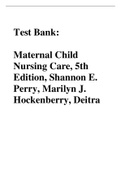Test Bank:
Maternal Child
Nursing Care, 5th
Edition, Shannon E.
Perry, Marilyn J.
Hockenberry, Deitra
,Chapter 01: 21st Century Maternity Nursing
MULTIPLE CHOICE
1. When providing care for a pregnant woman, the nurse should be aware that one of the most
frequently reported maternal medical risk factors is:
a. Diabetes mellitus. c. Chronic hypertension.
b. Mitral valve prolapse (MVP). d. Anemia.
ANS: A
The most frequently reported maternal medical risk factors are diabetes and hypertension
associated with pregnancy. Both of these conditions are associated with maternal obesity. There
are no studies that indicate MVP is among the most frequently reported maternal risk factors.
Hypertension associated with pregnancy, not chronic hypertension, is one of the most frequently
reported maternal medical risk factors. Although anemia is a concern in pregnancy, it is not one
of the most frequently reported maternal medical risk factors in pregnancy.
PTS: 1 DIF: Cognitive Level: Knowledge REF: 6
OBJ: Nursing Process: Assessment MSC: Client Needs: Physiologic Integrity
2. To ensure optimal outcomes for the patient, the contemporary maternity nurse must
incorporate both teamwork and communication with clinicians into her care delivery, The SBAR
technique of communication is an easy-to-remember mechanism for communication. Which of
the following correctly defines this acronym?
a. Situation, baseline assessment, response
b. Situation, background, assessment, recommendation
c. Subjective background, assessment, recommendation
, d. Situation, background, anticipated recommendation
ANS: B
The situation, background, assessment, recommendation (SBAR) technique provides a specific
framework for communication among health care providers. Failure to communicate is one of
the major reasons for errors in health care. The SBAR technique has the potential to serve as a
means to reduce errors.
PTS: 1 DIF: Cognitive Level: Comprehension REF: 14
OBJ: Nursing Process: Assessment, Planning
MSC: Client Needs: Safe and Effective Care Environment
3. The role of the professional nurse caring for childbearing families has evolved to emphasize:
a. Providing care to patients directly at the bedside.
b. Primarily hospital care of maternity patients.
c. Practice using an evidence-based approach.
d. Planning patient care to cover longer hospital stays.
ANS: C
Professional nurses are part of the team of health care providers who collaboratively care for
patients throughout the childbearing cycle. Providing care to patients directly at the bedside is
one of the nurse’s tasks; however, it does not encompass the concept of the evolved professional
nurse. Throughout the prenatal period, nurses care for women in clinics and physician’s offices
and teach classes to help families prepare for childbirth. Nurses also care for childbearing
families in birthing centers and in the home. Nurses have been critically important in developing
strategies to improve the well-being of women and their infants and have led the efforts to
implement clinical practice guidelines using an evidence-based approach. Maternity patients
have experienced a decreased, rather than an increased, length of stay over the past 2 decades.




